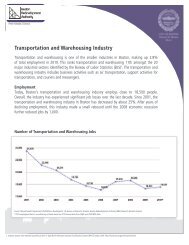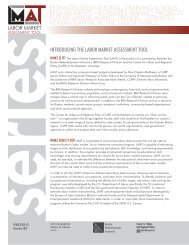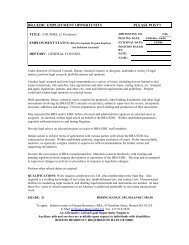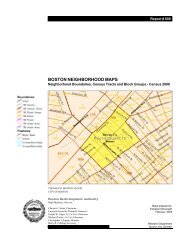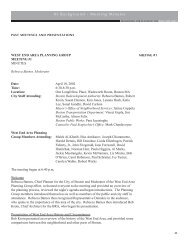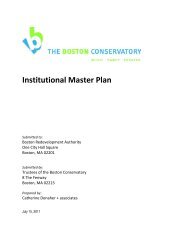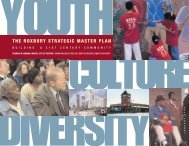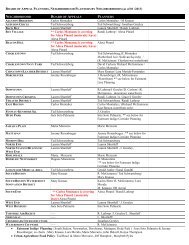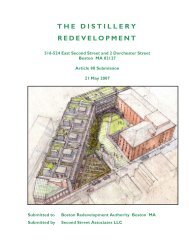Draft Project Impact Report - Boston Redevelopment Authority
Draft Project Impact Report - Boston Redevelopment Authority
Draft Project Impact Report - Boston Redevelopment Authority
Create successful ePaper yourself
Turn your PDF publications into a flip-book with our unique Google optimized e-Paper software.
Exeter Residences\888 Boylston<br />
Green Line Capacity<br />
\\Mabos\projects\09916.00\docs\Permits\DPIR\Text\DPIR Chapter 4<br />
Transportation081208-clean.docx<br />
Subway route capacity is a function of vehicle size and the frequency of service. The<br />
Green Line peak hour capacities for the B Line, C Line, D Line and E Line are based<br />
on a vehicle capacity of 100 passengers per car or 200 passengers per a two-car<br />
trainset. This assumes a conservative analysis since the D Line often provides threecar<br />
trains during the peak hours.<br />
Consistent with the bus analysis, the subway service rush-hour frequencies and<br />
ridership information, presented in Table 4-12 are based on the most current<br />
schedules and publications available from the MBTA.<br />
Table 4-12<br />
MBTA Green Line Peak Hour Utilization (Existing Conditions)<br />
Frequency 1<br />
Peak Hour<br />
Capacity 2<br />
Transportation 4-33<br />
Peak Hour<br />
Ridership Utilization<br />
Green Line<br />
Inbound 104 8,736 8,104 AM Peak 93%<br />
Outbound 104 8,736 7,386 PM Peak 85%<br />
1 – cars per hour, source: MBTA Bus Routes schedules and comprehensive Ridecheck Program (Winter 2000)<br />
2- in number of passengers<br />
As shown in Table 4-12, there is adequate capacity on the D Line and E Line to<br />
accommodate the peak hour loads. This analysis assumes that all trains arrive on<br />
schedule and that passengers are evenly distributed throughout the hour. In reality,<br />
passenger loads can vary and some trains become more congested than others.<br />
However, over the course of the hour, there is an adequate train capacity to meet the<br />
demand.<br />
With the new Charlie Card system, the MBTA has the ability to monitor passenger<br />
loads and adjust schedules as needed to meet the customer demands. It is anticipated<br />
that with the expected growth in the Back Bay, the MBTA will provide more frequent<br />
service and increase the frequency of the three-car trainsets on the D Line as needed.<br />
With the construction of the proposed Urban Ring project, new connections will be<br />
made available within the MBTA system which will help to alleviate existing<br />
demands on major components of the public transportation system, which will<br />
eventually provide additional capacity to the Green Line operating in the Back Bay<br />
area.<br />
As presented in Table 4-10, the Exeter Residences and 888 Boylston buildings<br />
together will increase the planned transit ridership for the entire redevelopment<br />
program by 3.1% during the morning peak and 2.6% during the evening peak. This



